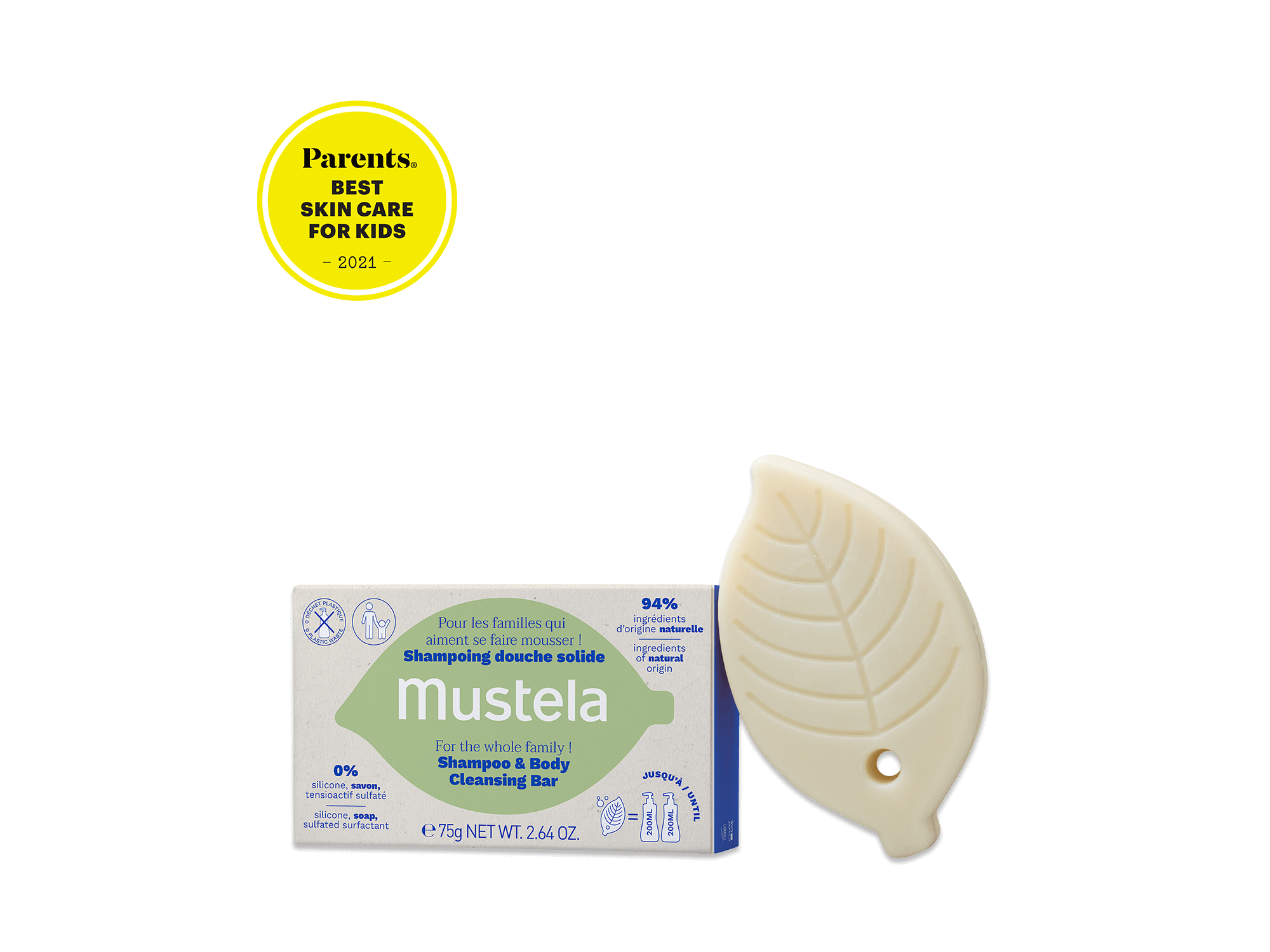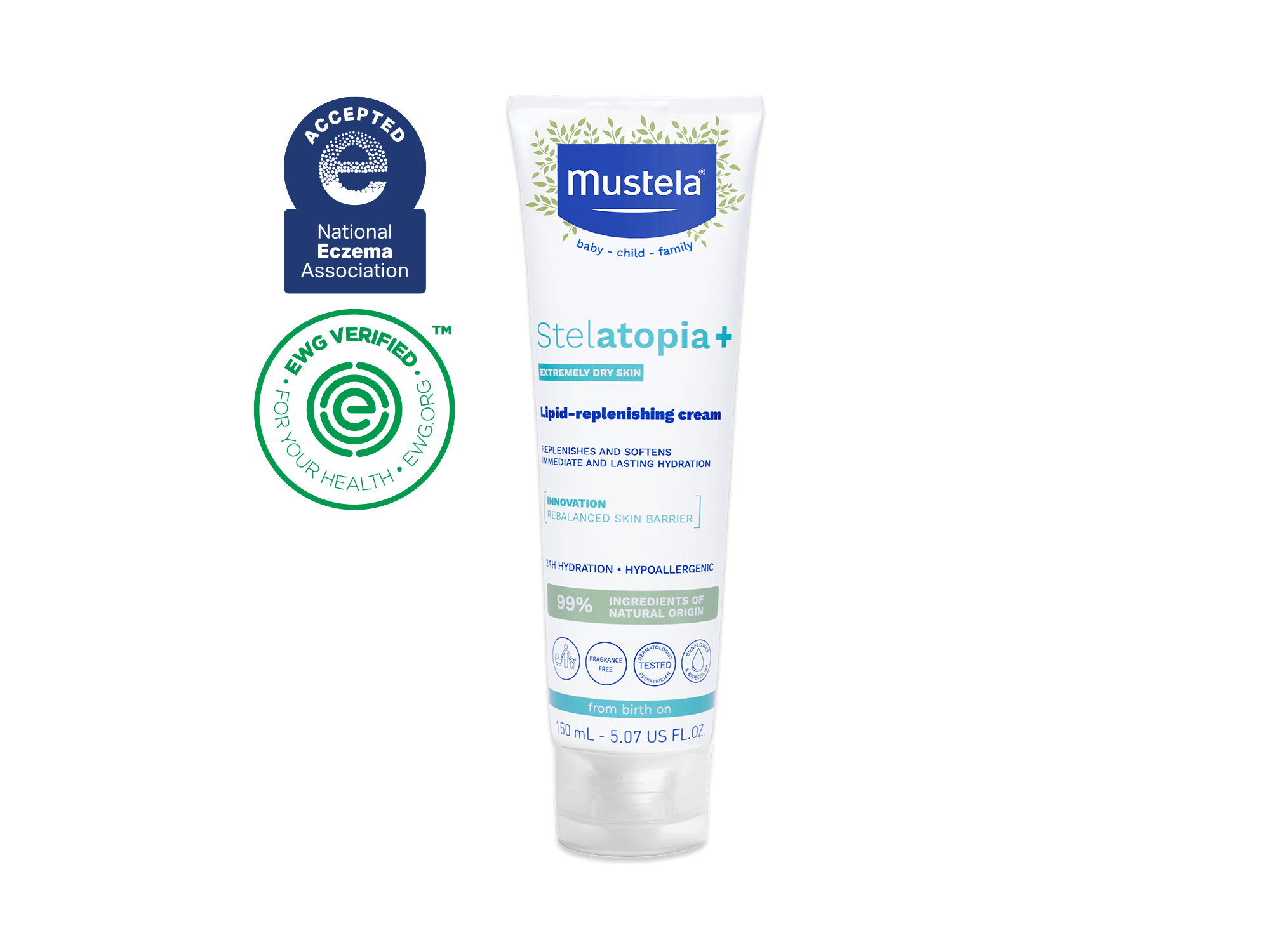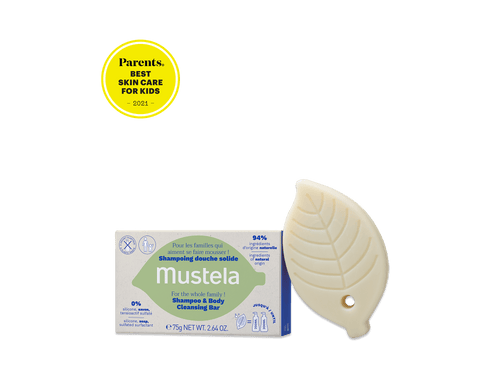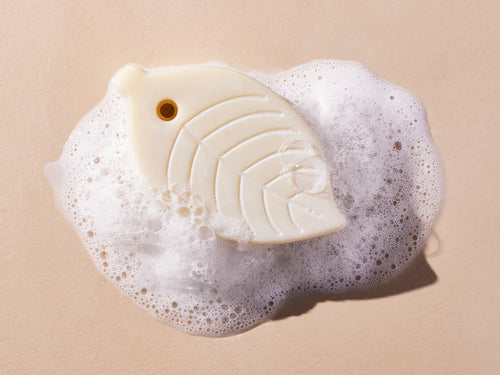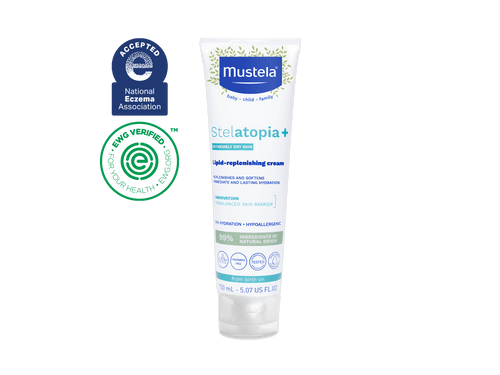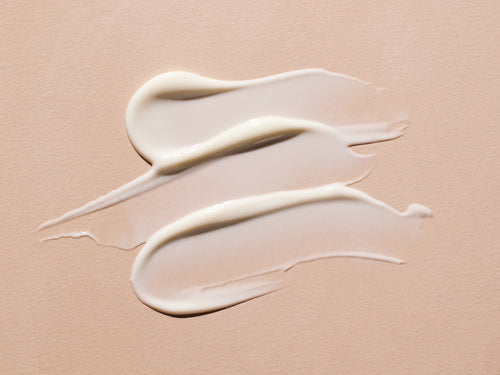Your baby has made it to their first birthday — congratulations! This is a huge milestone and should be celebrated as such. You and your 1 year old baby have certainly come a long way.
In this post, the baby experts at Mustela will discuss everything you need to know about caring for your 1 year old baby.
We’ll explain all the details about your little one’s development, senses, motor skills, eating schedule, sleeping habits, and immunizations, as well as some general childcare tips.
Caring For Your 1 Year Old Baby
Children change dramatically in their first year of life. In the first few weeks outside the womb, your newborn probably did little more than sleep and eat.
Now, just 12 short months later, your 1 year old baby is shuffling around your house, making efforts to communicate, and becoming a true individual.
All of these swift changes may have left you with a few questions. But don’t worry; we’re here to answer those questions for you.
Your 1 Year Old Baby’s Development
First, let’s cover your 1 year old baby’s height and weight. On average, one-year-old girls are 28.3 inches (72 cm) to 29.7 inches (75.5 cm) tall and weigh 18.1 pounds (8.2 kg) to 21.4 pounds (9.7 kg).
One-year-old boys are a bit bigger. The median 50 percent of boys are 29.1 inches (74 cm) to 30.5 inches (77.5 cm) in height and 19.6 pounds (8.9 kg) to 22.8 pounds (10.35 kg) in weight at 12 months of age.
Bear in mind that these figures are just averages. It’s no big deal if your 1 year old baby is bigger or smaller. Each child grows and develops at their own pace.

Your 1 Year Old Baby’s Senses
Seeing
By the time your baby is one year old, their senses are almost fully developed. Your little one’s vision is sharp, and they can see just as well as most adults. They are getting better at recognizing people, places, and objects.
Now is a great time to start exploring with your not-so-little baby. Take trips to the park or store to stimulate your baby’s sense of sight. Point to and name objects while you’re out and about.
Even if your baby isn’t quite walking yet, you can still go for a stroll. Secure your little one in their stroller and let the fun begin! Let them look at their surroundings, and their little mind will take it all in.
Direct their attention to all the trees and birds. If you’re at the park, your child can watch other children play, laugh, and run. And before you know it, your little one will be out there and you won’t be able to keep up with them!
Lastly, now that your baby can actually enjoy the scenery, take them on day trips — like to the aquarium, museum, or zoo — or overnight trips.
Hearing
While your little one’s hearing is already fully developed, they are now becoming better at understanding individual sounds and words. Basically, they are beginning to grasp that people, places, and objects have names.
Your 1 year old baby may even begin attaching a few names and words to the appropriate objects. For example, your baby probably knows their own name and responds to it at this point.
Or, if you ask where their brown stuffed teddy bear is, for instance, they may point to it or pick it up and show you. You can also give your little one other simple commands or ask them questions to see how much they understand.
Since your baby can hear pretty well by now, crank up the music! It’s so fun to watch your little one dance to the beat. Their little body will start moving and grooving to the music and respond to different genres.
The moments you’ve sung all those songs and read all those books to your baby is time well-spent. Continue reading and singing so your baby can listen to your voice, which helps shape their imagination for the years to come!

Tasting
As your 1 year old baby tries new foods, their sense of taste continues to develop. You’ve probably already noticed that they enjoy eating some foods more than others. This is perfectly normal.
Touching
Your little one is also curious about the way things feel and will want to touch practically everything they see.
Give your baby touch-and-feel books to explore, or go explore different textures outside, like the grass, soil, flowers, trees, leaves, pine cones, and more.
As your little one feels each texture, tell them what the object is. Their little mind is like a sponge and is literally soaking it all up!
If you can’t get outside, sensory toys are a great option for helping their growing mind and engaging their other senses.
While your baby explores their surroundings, be sure to keep an eye on them at all times so they don’t accidentally touch sharp objects or other potentially dangerous items.
Also, keep an eye out for anything small that they can possibly put in their mouth since they are experimenting with their sense of taste as well.
Your 1 Year Old Baby’s Motor Skills

Gross Motor Skills
Around the one-year mark is when you may see your baby taking their first steps. They probably aren’t yet walking, per se, but they are likely taking a few steps here and there or using stable objects to help them stumble around your house.
And when your little one isn’t trying to walk, they are definitely crawling around like never before. All that tummy time is paying off!
With these movements, your baby is using their gross motor skills. Gross motor skills are the movements of the larger muscles, like in their arms and legs. Using these muscles will help your baby become a better walker.
And eventually, your baby will start running, really engaging those larger muscles. It’s important to build up these muscles now so your baby can throw and catch a ball, run, kick, and have a better awareness of their body later on.
The larger muscles are also important for your baby’s balance and strength for the future. Your baby strengthens these muscles when they:
- Dance and move to music
- Do squats, moving up and down (they’ll do this before they start walking)
- Crawl on the floor
- Shake objects
- Grab a toy from your hand
- Pull up on a couch or chair

Fine Motor Skills
Your 1 year old baby is now able to pick up and grasp a wide variety of objects. This means they can start picking up smaller toys to play with, and they can use crayons to scribble on paper.
Your little one can also begin to feed themselves small finger foods. Consider introducing a spoon and a sippy cup at mealtimes, and allow your baby to practice eating and drinking solo.
With these particular movements, your baby is using their fine motor skills. Fine motor skills are the movements of the small muscles, like in their fingers and wrists.
Using these muscles will come in handy down the road when your child starts tying their shoes, writing their name, cutting paper, building legos, buttoning their shirt, or zipping their jacket.
Practice these skills early on with your little one to help build and strengthen those muscles for the future by:
- Giving them a crayon to scribble with
- Giving them blocks to stack
- Giving them a spoon or fork at mealtime
These are just a few ideas to help your child build up the muscles in their fingers and wrists.
Make sure to give your child plenty of opportunities throughout the day to use all of their muscles. Remember, offer toys or safe household objects they can:
- Twist
- Spin
- Turn
- Dump
- Push
- Pull
- Bang
- Bounce
- Throw
- Stack
- Knock over
Your 1 Year Old Baby’s Communication
Communication, both verbal and non-verbal, really starts taking off around the 12-month mark. Your little one may be able to utter a few words — Mama, Dada, and the all-important “no” are a few common ones.
But most of your 1 year old baby’s communication is non-verbal. They are likely now pointing at objects, shaking and nodding their heads, and using body language to communicate their feelings.
Now is the perfect time to introduce sign language to your baby, especially for basic words like “thank you,” “more,” “please,” “yes,” “no,” and so on.
Teaching your baby these signs early on will help them communicate with you better, especially if your little one is still working on their verbal communication skills. Plus, you’re teaching them two languages!
For example, your little one might grab their shoes if they want to go outside, or maybe they’ll pull your finger and lead you into the kitchen if they’re hungry. They’ll find ways to communicate with you to let you know what they want even if they can’t verbally say it.
Savor these sweet little moments of watching your little one get creative in finding ways to communicate!
Your 1 Year Old Baby’s Eating Schedule

Healthcare professionals agree that a substantial portion of a baby’s diet should be breast milk and/or baby formula until one year of age. At this point, with the go-ahead from your baby’s pediatrician, you can consider weaning your baby.
If you prefer to continue breastfeeding, that’s great. Breastfeeding can continue for the first two years of a child’s life. But some moms choose to wean their babies around the one-year mark.
Your child started eating solid foods sometime around six months of age and now, at one year old, their body is ready to process pretty much anything. The only catch is that your little one’s teeth are still coming in, so they might not be able to chew tougher foods.
You can also begin introducing cow’s milk to your child’s diet after their first birthday. They may not like the taste at first, but be patient and continue to feed it to your little one. They’ll get used to it soon.
When you do decide to give your baby cow’s milk, skip the low-fat milk and choose Vitamin D whole milk instead. Your baby needs the extra fat contained in Vitamin D milk.
That being said, don’t give your baby too much milk. They may actually fill up on that rather than on food, which is not ideal.
You want your baby to fill up on calories from their food, not from their drink. We recommend only offering your baby milk at breakfast, lunch, and dinner.
At this age, your baby should get three meals per day and at least two snacks per day. Offer your baby water throughout the day and skip the sugary juices for now.

For meals, your baby is now pretty much eating what you’re eating. However, remember some tougher foods and foods that are a choking hazard might not be suitable. Use your best judgment.
Start with breaking the food, especially meat, into smaller pieces, and let your baby use their fingers (their pincer grasp) to pick up their food.
Meals can easily become playtime...and that’s OK! Except if they’re throwing food all over the table, of course!
Let your baby explore. See what they like and what they don’t like. Maybe just offer one food at a time instead of offering your baby a full plate of different foods at once.
For example, give them some veggies first (something you know they might be hesitant to try). If you give them something when they're really hungry, they’re more likely to try it and actually eat it!
Then offer the meat followed by fruit. Most one-year-olds have no problem eating fruit, so you can save the best for last! Remember, you decide what your baby eats. They decide how much.
Lastly, allow your baby to sit at the table with the family for meals. Mealtime is more than just eating. It’s about the experience of gathering around the table and spending time with family.
Starting early will help your family establish a good mealtime routine that you’ll cherish for years to come!
Your 1 Year Old Baby’s Sleeping Habits

Your 1 year old baby is sleeping roughly 13 to 14 hours per day. More than likely, your baby is sleeping around ten hours at night and then another three or four hours during the day. Daytime sleep normally comes via a mid-morning nap and an afternoon nap.
However, at this age, you might notice your baby starting to drop one of those naps, with daytime sleep eventually merging into one long nap. Your little one might sleep 12 hours at night now with one two-hour nap during the day.
Some one-year-olds experience sleep regression, which means they may have previously slept well through the night but are now having trouble. This is normal and, while it can be tough on parents, is nothing to be worried about.
Sleep regression can happen when your baby’s sleep patterns change naturally or when there are changes to your location or schedule.
But, if your 1 year old baby is waking up frequently during the night, establish a bedtime routine and allow your little one to lie in bed when they are still awake (rather than letting them fall asleep somewhere else and then carrying them to bed).
This helps them learn to fall asleep on their own. It also helps them fall back asleep without you and your partner if they wake up in the middle of the night.
Expert tip: If your little one struggles with eczema or sensitive skin, dress them in our Stelatopia Skin Soothing Pajamas for a comfy and restful night’s sleep!
Your 1 Year Old Baby’s Immunizations
When you go to the doctor’s office for your 1 year old baby’s checkup, be prepared for a round of immunization shots. Assuming your baby is current on all their previous shots, here’s what they will receive at the one-year visit to the doctor:
- The first round of Hepatitis A vaccine
- The third round of Hepatitis B vaccination
- The fourth round of HIB vaccine
- The fourth round of PCV vaccine
- Measles, mumps, rubella, and varicella vaccine (MMRV)
It’s never fun to watch your baby get shots, but immunizations are extremely important, so make sure your little one is up to date.
General Childcare Tips For Your One Year Old

At 12 months of age, your baby is able to move around the house with relative ease. That’s why it’s so important to babyproof your home and always keep an eye on your little one. Never leave them unattended, not even for a second.
As your little one is now eating more solid foods than ever, introduce new foods one at a time and keep an eye out for signs of allergies, like hives or rashes.
Pay attention to your baby’s dirty diapers too. Loose stool is an indication of a new food disagreeing with your little one’s tummy. Consult a doctor if your baby has diarrhea for more than 24 hours.
Finally, always take excellent care of your little one’s delicate skin. Skin conditions like baby acne, eczema, and cradle cap are not uncommon but are easily treated with adequate attention to your child’s skincare routine.
Bathtime

Bathtime is a good activity to help your one-year-old wind down and relax before they go to sleep. But you might notice your very active one-year-old is a little more fidgety in the bathtub than they once were.
This is because they’ve learned a lot of new skills by now — standing, pulling up, and possibly walking. And now you’re noticing them practicing their new skills in the bathtub, which can be cute but dangerous.
So keep an eye and a hand on your baby at all times when they’re in the tub. A good rule of thumb is to go ahead and wash your baby first and then let them play.
Sometimes they can play for too long and then get fussy, which makes washing them a little bit tricky. So go ahead and wash your baby first and then let them play their heart out.
While you’re washing them, try our Organic Cleansing Gel with Olive Oil and Aloe to not only clean your baby’s skin but also to keep it healthy. Then, let your baby explore and use their senses with our Multi-Sensory Bubble Bath!
To wrap up your baby’s day after their bath, give them a little massage and hydrate their skin with our Hydra Bebe Body Lotion. Now your little one is definitely ready for a good night’s sleep!
Prepare For Toddler Take-Off!
Reaching your child’s first birthday is a special time. It’s a great opportunity to reflect on the last 12 months and think of all the amazing things to come. Toddlerhood is next, so take lots of photos and enjoy the journey of parenthood!




